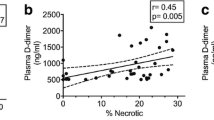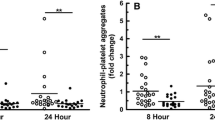Abstract
To derive insights into the temporal changes in oxidative, inflammatory and coagulation biomarkers in patients with stable angina undergoing percutaneous coronary intervention (PCI). PCI is associated with a variety of biochemical and mechanical stresses to the vessel wall. Oxidized phospholipids are present on plasminogen (OxPL-PLG) and potentiate fibrinolysis in vitro. We recently showed that OxPL-PLG increase following acute myocardial infarction, suggesting that they are involved in atherothrombosis. Plasma samples were collected before, immediately after, 6 and 24 h, 3 and 7 days, and 1, 3, and 6 months after PCI in 125 patients with stable angina undergoing uncomplicated PCI. Plasminogen levels, OxPL-PLG, and an array of 16 oxidative, inflammatory and coagulation biomarkers were measured with established assays. OxPL-PLG and plasminogen declined significantly immediately post-PCI, rebounded to baseline, peaked at 3 days and slowly returned to baseline by 6 months (p < 0.0001 by ANOVA). The temporal trends to maximal peak in biomarkers were as follows: immediately post PCI: OxPL-apoB and lipoprotein (a); Day 1—the inflammatory biomarker IL-6; Day 3—CRP and coagulation biomarkers OxPL-PLG, plasminogen and tissue plasminogen activity; Day 3 to 7—plasminogen activator inhibitor activity, and complement factor H binding to malondialdehyde-LDL and MDA-LDL IgG; Day 7–30 MDA-LDL IgM, CuOxLDL IgM, and ApoB-IC IgM and IgG; >30 days uPA activity, uPA antigen, CuOxLDL IgG and peptide mimotope to MDA-LDL. Most of the biomarkers trended to baseline by 6 months. PCI results in a specific, temporal sequence of changes in plasma biomarkers. These observations provide insights into the effects of iatrogenic barotrauma and plaque disruption during PCI and suggest avenues of investigation to explain complications of PCI and development of targeted therapies to enhance procedural success.





Similar content being viewed by others
References
Prati F, Pawlowski T, Gil R, Labellarte A, Gziut A, Caradonna E et al (2003) Stenting of culprit lesions in unstable angina leads to a marked reduction in plaque burden: a major role of plaque embolization? A serial intravascular ultrasound study. Circulation. 107(18):2320–2325
Ravandi A, Leibundgut G, Hung M-Y, Patel M, Hutchins PM, Murphy RC et al (2014) Release and capture of bioactive oxidized phospholipids and oxidized cholesteryl esters during percutaneous coronary and peripheral arterial interventions in humans. J Am Coll Cardiol 21(63):1961–1971
Juni RP, Duckers HJ, Vanhoutte PM, Virmani R, Moens AL (2013) Oxidative stress and pathological changes after coronary artery interventions. J Am Coll Cardiol 61(14):1471–1481
Breuss JM, Cejna M, Bergmeister H, Kadl A, Baumgartl G, Steurer S et al (2002) Activation of nuclear factor-κB significantly contributes to lumen loss in a rabbit iliac artery balloon angioplasty model. Circulation 105(5):633–638
van Dijk RA, Kolodgie F, Ravandi A, Leibundgut G, Hu PP, Prasad A et al (2012) Differential expression of oxidation-specific epitopes and apolipoprotein(a) in progressing and ruptured human coronary and carotid atherosclerotic lesions. J Lipid Res 53(12):2773–2790
Choi S-H, Yin H, Ravandi A, Armando A, Dumlao D, Kim J et al (2013) Polyoxygenated cholesterol ester hydroperoxide activates TLR4 and SYK dependent signaling in macrophages. PLoS One 8(12):e83145
Tsimikas S, Lau HK, Han K-R, Shortal B, Miller ER, Segev A et al (2004) Percutaneous coronary intervention results in acute increases in oxidized phospholipids and lipoprotein(a): short-term and long-term immunologic responses to oxidized low-density lipoprotein. Circulation 109(25):3164–3170
Fefer P, Tsimikas S, Segev A, Sparkes J, Otsuma F, Kolodgie F et al (2012) The role of oxidized phospholipids, lipoprotein (a) and biomarkers of oxidized lipoproteins in chronically occluded coronary arteries in sudden cardiac death and following successful percutaneous revascularization. Cardiovasc Revasc Med. 13(1):11–19
Segev A, Strauss BH, Witztum JL, Lau HK, Tsimikas S (2005) Relationship of a comprehensive panel of plasma oxidized low-density lipoprotein markers to angiographic restenosis in patients undergoing percutaneous coronary intervention for stable angina. Am Heart J 150(5):1007–1014
Tsimikas S, Kiechl S, Willeit J, Mayr M, Miller ER, Kronenberg F et al (2006) Oxidized phospholipids predict the presence and progression of carotid and femoral atherosclerosis and symptomatic cardiovascular disease: five-year prospective results from the Bruneck study. J Am Coll Cardiol 47(11):2219–2228
Leibundgut G, Arai K, Orsoni A, Yin H, Scipione C, Miller ER et al (2012) Oxidized phospholipids are present on plasminogen, affect fibrinolysis, and increase following acute myocardial infarction. J Am Coll Cardiol. 59(16):1426–1437
Strauss BH, Lau HK, Bowman KA, Sparkes J, Chisholm RJ, Garvey MB et al (1999) Plasma urokinase antigen and plasminogen activator inhibitor-1 antigen levels predict angiographic coronary restenosis. Circulation 100(15):1616–1622
Taleb A, Witztum JL, Tsimikas S (2011) Oxidized phospholipids on apoB-100-containing lipoproteins: a biomarker predicting cardiovascular disease and cardiovascular events. Biomark Med 5(5):673–694
Bertoia ML, Pai JK, Lee J-H, Taleb A, Joosten MM, Mittleman MA et al (2013) Oxidation-specific biomarkers and risk of peripheral artery disease. J Am Coll Cardiol 61(21):2169–2179
Capoulade R, Chan KL, Yeang C, Mathieu P, Bossé Y, Dumesnil JG et al (2015) Oxidized phospholipids, lipoprotein(a), and progression of calcific aortic valve stenosis. J Am Coll Cardiol 66(11):1236–1246
Byun YS, Lee J-H, Arsenault BJ, Yang X, Bao W, DeMicco D et al (2015) Relationship of oxidized phospholipids on apolipoprotein B-100 to cardiovascular outcomes in patients treated with intensive versus moderate atorvastatin therapy: the TNT trial. J Am Coll Cardiol 65(13):1286–1295
Weismann D, Hartvigsen K, Lauer N, Bennett KL, Scholl HPN, Charbel Issa P et al (2011) Complement factor H binds malondialdehyde epitopes and protects from oxidative stress. Nature 478(7367):76–81
Witztum JL, Lichtman AH (2014) The influence of innate and adaptive immune responses on atherosclerosis. Annu Rev Pathol 9:73–102
Tsimikas S, Mallat Z, Talmud PJ, Kastelein JJP, Wareham NJ, Sandhu MS et al (2010) Oxidation-specific biomarkers, lipoprotein(a), and risk of fatal and nonfatal coronary events. J Am Coll Cardiol 56(12):946–955
Kiechl S, Willeit J, Mayr M, Viehweider B, Oberhollenzer M, Kronenberg F et al (2007) Oxidized phospholipids, lipoprotein(a), lipoprotein-associated phospholipase A2 activity, and 10-year cardiovascular outcomes: prospective results from the Bruneck study. Arterioscler Thromb Vasc Biol 27(8):1788–1795
Rodenburg J, Vissers MN, Wiegman A, Miller ER, Ridker PM, Witztum JL et al (2006) Oxidized low-density lipoprotein in children with familial hypercholesterolemia and unaffected siblings: effect of pravastatin. J Am Coll Cardiol 47(9):1803–1810
Amir S, Hartvigsen K, Gonen A, Leibundgut G, Que X, Jensen-Jarolim E et al (2012) Peptide mimotopes of malondialdehyde epitopes for clinical applications in cardiovascular disease. J Lipid Res 53(7):1316–1326
Segev A, Kassam S, Buller CE, Lau HK, Sparkes JD, Connelly PW et al (2004) Pre-procedural plasma levels of C-reactive protein and interleukin-6 do not predict late coronary angiographic restenosis after elective stenting. Eur Heart J 25(12):1029–1035
Tsimikas S, Bergmark C, Beyer RW, Patel R, Pattison J, Miller E et al (2003) Temporal increases in plasma markers of oxidized low-density lipoprotein strongly reflect the presence of acute coronary syndromes. J Am Coll Cardiol 41(3):360–370
Heusch G, Kleinbongard P, Böse D, Levkau B, Haude M, Schulz R et al (2009) Coronary microembolization: from bedside to bench and back to bedside. Circulation 120(18):1822–1836
Sato H, Iida H, Tanaka A, Tanaka H, Shimodouzono S, Uchida E et al (2004) The decrease of plaque volume during percutaneous coronary intervention has a negative impact on coronary flow in acute myocardial infarction: a major role of percutaneous coronary intervention-induced embolization. J Am Coll Cardiol 44(2):300–304
Leineweber K, Böse D, Vogelsang M, Haude M, Erbel R, Heusch G (2006) Intense vasoconstriction in response to aspirate from stented saphenous vein aortocoronary bypass grafts. J Am Coll Cardiol 47(5):981–986
Hojo Y, Ikeda U, Katsuki T, Mizuno O, Fukazawa H, Kurosaki K et al (2000) Release of endothelin 1 and angiotensin II induced by percutaneous transluminal coronary angioplasty. Catheter Cardiovasc Interv 51(1):42–49
Schachinger V, Halle M, Minners J, Berg A, Zeiher AM (1997) Lipoprotein(a) selectively impairs receptor-mediated endothelial vasodilator function of the human coronary circulation. J Am Coll Cardiol 30(4):927–934
Gallimore MJ, Aasen AO, Erichsen NS, Larsbraaten M, Lyngaas K, Amundsen E (1980) Plasminogen concentrations and functional activities and concentrations of plasmin inhibitors in plasma samples from normal subjects and patients with septic shock. Thromb Res 18(5):601–608
Donoso LA, Vrabec T, Kuivaniemi H (2010) The role of complement factor H in age-related macular degeneration: a review. Surv Ophthalmol 55(3):227–246
Koeijvoets KCMC, Mooijaart SP, Dallinga-Thie GM, Defesche JC, Steyerberg EW, Westendorp RGJ et al (2009) Complement factor H Y402H decreases cardiovascular disease risk in patients with familial hypercholesterolaemia. Eur Heart J 30(5):618–623
Sofat R, Casas JP, Kumari M, Talmud PJ, Ireland H, Kivimaki M et al (2010) Genetic variation in complement factor H and risk of coronary heart disease: eight new studies and a meta-analysis of around 48,000 individuals. Atherosclerosis. 213(1):184–190
Pai JK, Manson JE, Rexrode KM, Albert CM, Hunter DJ, Rimm EB (2007) Complement factor H (Y402H) polymorphism and risk of coronary heart disease in US men and women. Eur Heart J 28(11):1297–1303
Meng W, Hughes A, Patterson CC, Belton C, Kamaruddin MS, Horan PG et al (2007) Genetic variants of complement factor H gene are not associated with premature coronary heart disease: a family-based study in the Irish population. BMC Med Genet 8:62
Iltumur K, Karabulut A, Toprak G, Toprak N (2005) Complement activation in acute coronary syndromes. APMIS. 113(3):167–174
Ferluga J, Kishore U, Sim RB (2014) A potential anti-coagulant role of complement factor H. Mol Immunol 59(2):188–193
Ramharack R, Barkalow D, Spahr MA (1998) Dominant negative effect of TGF-beta1 and TNF-alpha on basal and IL-6-induced lipoprotein(a) and apolipoprotein(a) mRNA expression in primary monkey hepatocyte cultures. Arterioscler Thromb Vasc Biol 18(6):984–990
DeFilippis AP, Chernyavskiy I, Amraotkar AR, Trainor PJ, Kothari S, Ismail I et al (2015) Circulating levels of plasminogen and oxidized phospholipids bound to plasminogen distinguish between atherothrombotic and non-atherothrombotic myocardial infarction. J Thromb Thrombolysis. 2015:1–6
Leibundgut G, Witztum JL, Tsimikas S (2013) Oxidation-specific epitopes and immunological responses: translational biotheranostic implications for atherosclerosis. Curr Opin Pharmacol. 2013:1–12
Tsimikas S, Willeit P, Willeit J, Santer P, Mayr M, Xu Q et al (2012) Oxidation-specific biomarkers, prospective 15-year cardiovascular and stroke outcomes, and net reclassification of cardiovascular events. J Am Coll Cardiol 60(21):2218–2229
Tsimikas S, Duff GW, Berger PB, Rogus J, Huttner K, Clopton P et al (2014) Pro-inflammatory interleukin-1 genotypes potentiate the risk of coronary artery disease and cardiovascular events mediated by oxidized phospholipids and lipoprotein(a). J Am Coll Cardiol 63(17):1724–1734
Briley-Saebo K, Yeang C, Witztum JL, Tsimikas S (2014) Imaging of oxidation-specific epitopes with targeted nanoparticles to detect high-risk atherosclerotic lesions: progress and future directions. J Cardiovasc Transl Res. 7(8):719–736
Binder CJ, Horkko S, Dewan A, Chang M-K, Kieu EP, Goodyear CS et al (2003) Pneumococcal vaccination decreases atherosclerotic lesion formation: molecular mimicry between Streptococcus pneumoniae and oxidized LDL. Nat Med 9(6):736–743
Tsimikas S, Miyanohara A, Hartvigsen K, Merki E, Shaw PX, Chou M-Y et al (2011) Human oxidation-specific antibodies reduce foam cell formation and atherosclerosis progression. J Am Coll Cardiol 58(16):1715–1727
Fang L, Green SR, Baek JS, Lee S-H, Ellett F, Deer E et al (2011) In vivo visualization and attenuation of oxidized lipid accumulation in hypercholesterolemic zebrafish. J Clin Invest. 121(12):4861–4869
Funding Sources
This study was funded by the Swiss National Science Foundation PBBSP3-124742 and the Swiss Academy of Medical Sciences PASMP3_132566 (G.L.) and NIH HL119828, HL055798, HL088093, HL106579, HL078610, HL124174. (S.T.).
Author information
Authors and Affiliations
Corresponding author
Ethics declarations
Disclosures
Dr. Tsimikas is a co-inventor and receives royalties for patents owned by the University of California for the clinical use of oxidation-specific antibodies and currently holds a dual appointment at UCSD and as an employee of Ionis Pharmaceuticals.
Electronic supplementary material
Below is the link to the electronic supplementary material.
Rights and permissions
About this article
Cite this article
Leibundgut, G., Lee, JH., Strauss, B.H. et al. Acute and long-term effect of percutaneous coronary intervention on serially-measured oxidative, inflammatory, and coagulation biomarkers in patients with stable angina. J Thromb Thrombolysis 41, 569–580 (2016). https://doi.org/10.1007/s11239-016-1351-6
Published:
Issue Date:
DOI: https://doi.org/10.1007/s11239-016-1351-6




